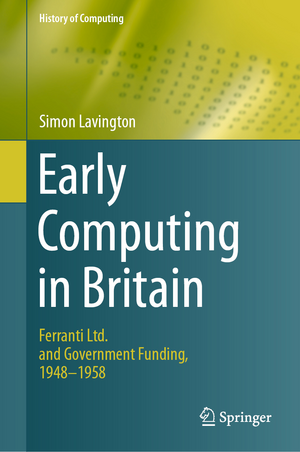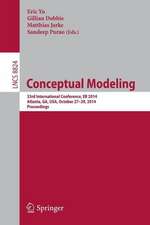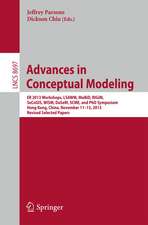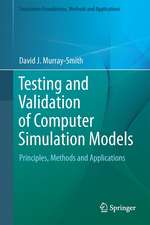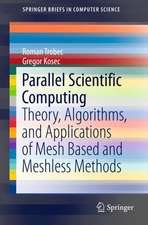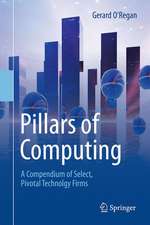Early Computing in Britain: Ferranti Ltd. and Government Funding, 1948 — 1958: History of Computing
Autor Simon Lavingtonen Limba Engleză Hardback – 16 iul 2019
Topics and features: provides the historical background to the Ferranti Mark I, including the contributions of von Neumann and Turing, and the prototype known as The Baby; describes the transfer of technologies from academia to industry and the establishment of Ferranti’s computer production resources; reviews Ferranti’s efforts to adapt their computers for sale to business and commercial markets,and to introduce competitive new products; covers the use of early Ferranti computers for defence applications in different government establishments in the UK, including GCHQ Cheltenham; discusses the installation and applications of Ferranti computers at universities in the UK, Canada, and Italy; presents the story of the purchase of a Ferranti Mark I* machine by the Amsterdam Laboratories of the Shell company; details the use of Ferranti Mark I* computers in the UK’s aerospace industry and compares this with the American scene; relates the saga of Ferranti’s journey from its initial success as the first and largest British computer manufacturer to its decline and eventual bankruptcy.
This highly readable text/reference will greatly appeal to professionals interested in the practical development of early computers, as well as to specialists in computer history seeking technical material not readily available elsewhere. The educated general reader will also find much to enjoy in the photographs and personal anecdotes that provide an accessible insight into the early days of computing.
| Toate formatele și edițiile | Preț | Express |
|---|---|---|
| Paperback (1) | 281.10 lei 6-8 săpt. | |
| Springer International Publishing – 14 aug 2020 | 281.10 lei 6-8 săpt. | |
| Hardback (1) | 287.50 lei 6-8 săpt. | |
| Springer International Publishing – 16 iul 2019 | 287.50 lei 6-8 săpt. |
Din seria History of Computing
- 21%
 Preț: 248.72 lei
Preț: 248.72 lei - 20%
 Preț: 276.62 lei
Preț: 276.62 lei - 20%
 Preț: 440.22 lei
Preț: 440.22 lei - 20%
 Preț: 987.57 lei
Preț: 987.57 lei -
 Preț: 291.11 lei
Preț: 291.11 lei - 20%
 Preț: 224.97 lei
Preț: 224.97 lei -
 Preț: 253.85 lei
Preț: 253.85 lei -
 Preț: 294.37 lei
Preț: 294.37 lei -
 Preț: 326.35 lei
Preț: 326.35 lei - 20%
 Preț: 176.49 lei
Preț: 176.49 lei - 20%
 Preț: 270.51 lei
Preț: 270.51 lei - 20%
 Preț: 333.54 lei
Preț: 333.54 lei - 20%
 Preț: 764.76 lei
Preț: 764.76 lei - 20%
 Preț: 229.81 lei
Preț: 229.81 lei - 20%
 Preț: 273.64 lei
Preț: 273.64 lei - 20%
 Preț: 227.29 lei
Preț: 227.29 lei -
 Preț: 315.80 lei
Preț: 315.80 lei -
 Preț: 479.72 lei
Preț: 479.72 lei - 20%
 Preț: 235.56 lei
Preț: 235.56 lei - 20%
 Preț: 638.55 lei
Preț: 638.55 lei - 20%
 Preț: 216.00 lei
Preț: 216.00 lei - 20%
 Preț: 1008.62 lei
Preț: 1008.62 lei - 20%
 Preț: 270.19 lei
Preț: 270.19 lei - 20%
 Preț: 983.71 lei
Preț: 983.71 lei - 20%
 Preț: 224.50 lei
Preț: 224.50 lei -
 Preț: 375.40 lei
Preț: 375.40 lei - 20%
 Preț: 1046.71 lei
Preț: 1046.71 lei - 20%
 Preț: 645.31 lei
Preț: 645.31 lei -
 Preț: 238.69 lei
Preț: 238.69 lei - 20%
 Preț: 360.71 lei
Preț: 360.71 lei - 20%
 Preț: 281.10 lei
Preț: 281.10 lei -
 Preț: 325.97 lei
Preț: 325.97 lei -
 Preț: 325.43 lei
Preț: 325.43 lei
Preț: 287.50 lei
Preț vechi: 359.37 lei
-20% Nou
Puncte Express: 431
Preț estimativ în valută:
55.03€ • 59.80$ • 46.26£
55.03€ • 59.80$ • 46.26£
Carte tipărită la comandă
Livrare economică 21 aprilie-05 mai
Preluare comenzi: 021 569.72.76
Specificații
ISBN-13: 9783030151027
ISBN-10: 3030151026
Pagini: 358
Ilustrații: XV, 392 p. 134 illus., 51 illus. in color.
Dimensiuni: 155 x 235 mm
Greutate: 0.75 kg
Ediția:1st ed. 2019
Editura: Springer International Publishing
Colecția Springer
Seria History of Computing
Locul publicării:Cham, Switzerland
ISBN-10: 3030151026
Pagini: 358
Ilustrații: XV, 392 p. 134 illus., 51 illus. in color.
Dimensiuni: 155 x 235 mm
Greutate: 0.75 kg
Ediția:1st ed. 2019
Editura: Springer International Publishing
Colecția Springer
Seria History of Computing
Locul publicării:Cham, Switzerland
Cuprins
The Small Seeds of Innovation.- Academic/Industrial Collaboration: from Chorlton-on-Medlock to Moston, and Back.- Canada Calling: Toronto Gets a Mark I.- A Star is Born: Ideas and Upgrades.- Into the Market.- The AVRO Mark I* Installation at Chadderton.- The Mark I* at Armstrong Siddeley, Ansty, Coventry.- The Ferranti Mark I* Installation in Amsterdam.- The Ferranti Mark I* Installation in Rome.- GCHQ Cheltenham’s Mark I*.- The Mark I* at the Armaments Research Development Establishment, Fort Halstead.- The Mark I* at the Atomic Weapons Research Establishment, Aldermaston.- What Came Next?.- Appendix A: Baby’s Conception: the Back Story.- Appendix B: Mark I and Mark I* Software Details.- Appendix C: Mark I and Mark I* Hardware Details.- Appendix D: Naming Names.- Appendix E: Performance, Cost and Delivery Details of Other Computers.
Notă biografică
Simon Lavington is Emeritus Professor of Computer Science at the University of Essex, UK. His other publications include the Springer title Moving Targets: Elliott-Automation and the Dawn of the Computer Age in Britain, 1947 – 67.
Textul de pe ultima copertă
This unique book presents the story of the pioneering manufacturing company Ferranti Ltd. – producer of the first commercially-available computers – and of the nine end-user organisations who purchased these machines with government help in the period 1951 to 1957. The text presents personal reminiscences from many of the diverse engineers, programmers and marketing staff who contributed to this important episode in the emergence of modern computers, further illustrated by numerous historical photographs. Considerable technical details are also supplied in the appendices.
Topics and features:
Simon Lavington is Emeritus Professor of Computer Science at the University of Essex, UK. His other publications include the Springer title Moving Targets: Elliott-Automation and the Dawn of the Computer Age in Britain, 1947 – 67.
Topics and features:
- Provides the historical background to the Ferranti Mark I, including the contributions of von Neumann and Turing, and the prototype known as The Baby
- Describes the transfer of technologies from academia to industry and the establishment of Ferranti’s computer production resources
- Reviews Ferranti’s efforts to adapt their computers for sale to business and commercial markets, and to introduce competitive new products
- Covers the use of early Ferranti computers for defence applications in different government establishments in the UK, including GCHQ Cheltenham
- Discusses the installation and applications of Ferranti computers at universities in the UK, Canada, and Italy
- Presents the story of the purchase of a Ferranti Mark I* machine by the Amsterdam Laboratories of the Shell company
- Details the use of Ferranti Mark I* computers in the UK’s aerospace industry and compares this with the American scene
- Relates the saga of Ferranti’s journey from its initial success as the first and largest British computer manufacturer to its decline and eventual bankruptcy
Simon Lavington is Emeritus Professor of Computer Science at the University of Essex, UK. His other publications include the Springer title Moving Targets: Elliott-Automation and the Dawn of the Computer Age in Britain, 1947 – 67.
Caracteristici
Examines the interactions and influences between the important computing innovators on both sides of the Atlantic during the seminal period 1945 to 1949 Analyses the hardware and software details of Ferranti computers and their competitors Describes in detail the computing requirements and contractual arrangements of the UK’s defence establishments Includes a large number of original photos of the significant people, places and equipment
